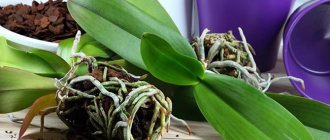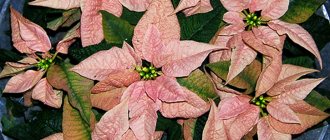Author: Elena N. https://floristics.info/ru/index.php?option=com_contact&view=contact&id=19 Category: Houseplants Published: February 05, 2019Last edits: April 17, 2021
- Growing from seeds
- Calceolaria rugosa (Calceolaria rugosa)
The plant calceolaria (lat. Calceolaria) belongs to the genus Calceolariaceae of the Norichnikov family, although English scientists distinguish the genus Calceolariaceae into a separate family. There are about 400 plant species in the genus, native to Central and South America. Translated, “calceolaria” means “slipper.” Representatives of the genus are herbaceous plants, subshrubs or shrubs; among them there are perennials, biennials and annuals, but in indoor culture, Calceolaria flowers are usually grown as annual herbaceous plants.
Planting and caring for calceolaria
- Flowering: in April or May for 3-5 weeks.
- Lighting: partial shade (north, north-west or east window).
- Temperature: no higher than 15˚C.
- Watering: constant, so that the soil in the pot is slightly moist all the time.
- Humidity: very high. It is recommended to keep the plant on a tray with wet pebbles or line the pot with peat and keep it moist at all times. It is not recommended to spray the plant.
- Feeding: two weeks after planting and before flowering begins, with mineral fertilizer solutions twice a month. In autumn and winter, fertilizing is not applied.
- Pruning: after flowering.
- Dormant period: after flowering for 1-1.5 months.
- Transplantation: do not replant. The lifespan of the plant is 2 seasons, then the plant no longer blooms.
- Reproduction: seeds, cuttings.
- Pests: aphids, whiteflies.
- Diseases: gray rot.
Read more about growing calceolaria below.
When to sow
In general, Calceolaria can be grown all year round. It all depends on when you need to get flowering:
- February crops will bloom in summer, and you can even take the bushes out into the garden;
- calceolaria sown in summer will bloom in early spring;
- April seedlings will produce buds in the fall.
When deciding when to sow, focus on a period of 6 months. Approximately this amount of time is needed for seedlings from the moment of germination to enter the flowering phase.
Botanical description
The calceolaria flower grows in height and width to approximately 30-50 cm. The leaves of the plant are lanceolate, corrugated, bright green in color, with pubescence on the underside of the leaf plate, reaching a length of 5 to 10 cm. The main advantage due to which calceolaria and has gained its popularity are its flowers, shaped like clogs in bright yellow, orange, white or red, plain, with strokes or speckled. The shape of the flower is very funny: it seems to consist of two lips - one large, inflated, spherical, and the other small, almost invisible. The indoor calceolaria flower blooms in April or May and blooms for 3-5 weeks. On one plant at the time of flowering, up to 50 flowers ranging in size from 2.5 to 6 cm can open.
Caring for calceolaria at home
Growing conditions
When it comes to caring for calceolaria, the most difficult thing is to create the conditions necessary for the plant. Caring for calceolaria flowers is complicated by the fact that heat and dry air are contraindicated for them, and in apartments not equipped with an air conditioning system, it is very hot and dry in the summer. Calceolaria at home prefers the partial shade of a northern, eastern or north-western window, a temperature not higher than 15 ºC and humid air, so you need to keep the pot with calceolaria on a tray with wet pebbles, and water it with soft, settled water so often that the soil does not dry out.
After flowering, watering is gradually reduced. To prevent the plant from suffering from dry air, you can keep the pot in a spacious pot, placing peat between the walls of the pot and flowerpot, which should be moist all the time. It is not advisable to spray calceolaria. If the plant is too hot and dry, it drops its buds, is easily attacked by pests and generally ages quickly.
- Indoor rhododendron (names and photos)
Fertilizer
Caring for calceolaria involves feeding the plant with soluble mineral fertilizers twice a month, starting two weeks from the moment the plant is planted until the start of flowering. In autumn and winter, the plant is not fertilized; after flowering, it is pruned and transferred for one and a half to two months to a cool, dark place, occasionally moistening the soil in the pot. When the calceolaria begins to grow new shoots, the intensity of moisture is gradually increased, the plant is moved to its usual place and mineral fertilizing is resumed.
Transfer
An overwintered plant blooms two months earlier than calceolaria grown from seeds this year, but the decorative value of last year's bush is significantly lower than that of a newly planted or purchased one, so professional flower growers recommend that calceolaria lovers buy or grow a new plant every year.
If you are faced with the problem of how to transplant a purchased plant from a technical pot into your own, decorative one, then this is easy to do: place a decent layer of drainage in the new pot, then transfer the plant along with a lump of earth from the technical pot to the decorative one and add soil for heather or substrate for geraniums to fill voids. You can make the soil for calceolaria yourself; for this you will need two parts of turf and leaf soil, one part of peat soil and half of sand.
Pests and diseases
The most common insect pests that infect Calceolaria are aphids and whiteflies. You can try to collect the aphids mechanically and destroy them, but if the infestation is total, you will have to resort to treating the plant with the chemical preparation actellik, which will help you out even if the calceolaria is infected with a whitefly. If the infection is too severe, it will be necessary to re-treat after 3-4 days - no more than four treatments with the same interval are allowed.
Of the diseases for calceolaria, gray rot is the most dangerous. It occurs when the plant has been subjected to chronic waterlogging for a long time at too low a temperature and too high humidity in the room. Growing calceolaria requires strict adherence to the rules, otherwise trouble may begin. An excessive concentration of nitrogen in fertilizers also weakens the plant, which provokes infection of the flower with gray mold. Severely affected areas are removed with a sharp knife, and the plant is sprayed with Bordeaux mixture or oxychome, topaz, cuproscat - any copper-containing preparation.
Transfer
Having bought seedlings or an adult flower, you should replant it so that it quickly gets used to the new conditions. You need to select the most suitable pot in terms of dimensions and replace the soil.
This will simplify further cultivation at home and will allow timely detection of a diseased plant. During transplantation, it is advisable to carry out anti-stress prophylaxis, using strengthening and growth-stimulating drugs.
Reproduction of calceolaria
Growing from seeds
If you don’t know how to grow calceolaria from seeds, buy it in a store or make your own mixture of sand and peat in a ratio of 1:7 with a small addition of ground chalk or dolomite flour (20 g per 1 kg of soil mixture). Calceolaria seeds are not in short supply; they can be purchased at any large specialized store, including online. Sowing of calceolaria seeds is carried out in April on a mixture previously disinfected by calcination and moistened, without embedding them in the soil, but covering the container with the seeds with glass or film, from which condensate will need to be removed as necessary.
- Hibiscus
Crops are kept in a warm (18 ºC), well-lit place, regularly ventilating and moistening the soil by spraying. After two weeks, when the shoots appear, they are watered in a thin stream between the rows. After a month, they are picked for the first time, and after another two months, when rosettes form, they are picked a second time into individual pots with a diameter of 7 cm, watered once every two weeks. In September, the seedlings are transplanted into pots with a diameter of 9-11 cm and placed in a bright and more than cool room - 8-10 ºC.
In January-February, calceolaria are planted in large pots with a nutrient mixture for adult plants, pinched at 3-4 leaves, transferred to a permanent place and wait for flowering, which usually occurs 8-10 months from the moment the seeds are sown.
Cuttings
You can try to root cuttings from shoots pruned after calceolaria flowering. Cuttings can be cut in August, or in February-March. Root the shoots in a nutritious soil mixture. Usually 3-4 weeks are enough for roots to appear. In order to get a dense bush, several rooted cuttings are planted in one pot.
Selection of capacity
To sow calceolaria seeds, at the initial stage you should take a small and not too deep container, which can be covered in order to create greenhouse conditions for better germination. For the first picking, the seedlings can be transplanted into a slightly larger container designed for several seedlings.
You can use plastic jars of yogurt, sour cream, or disposable cups.
The grown seedlings (1-2 months old) are already transplanted into a special plastic or ceramic pot to a permanent growing location. The optimal pot volume for normal cultivation without subsequent transplants is 0.8-1.2 liters. Drainage holes must be provided in the permanent pot.
Types and varieties
The most famous types of plants are:
Calceolaria rugosa (Calceolaria rugosa)
When in bloom, it looks like a cloud of yellow drops. It grows up to half a meter in height, small leaves form a rosette, small flowers 1.5-2 cm in diameter are painted pure yellow and decorated with brown specks.
Popular varieties:
- Sunset - leathery dark green leaves collected in a rosette, from which grows up to 10 short flower stalks with red, orange or yellow “shoes”;
- Goldbouquet is a large-flowered variety 25-30 cm high.
Mexican calceolaria (Calceolaria mexicana)
Pale yellow flowers up to 5 cm in diameter. Depending on growing conditions, it reaches from 20 to 50 cm in height.
Calceolaria purpurea
Herbaceous perennial up to 50 cm tall with spatulate, serrated basal leaves and small reddish-purple flowers with an oblong, grooved lower lip.
- Fatsia – care, photos, types
In indoor culture, the varieties and forms of plants most often grown are united under the name hybrid calceolaria (Calceolaria x herbeohybrida) . The leaves of these plants are usually light green, and the flowers are of a variety of colors - from boiling white to variegated in a variety of combinations. One of the popular varieties is Calceolaria Danti, a profusely flowering elegant plant with red flowers.
In addition to the above, calceolaria thin, tender, multi-petiolate and Darwin's calceolaria are also known.











